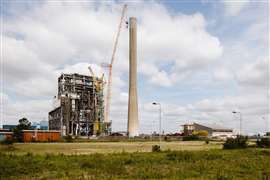Read this article in Français Deutsch Italiano Português Español
Epiroc releases SmartROC T30 R radio-remote drill rig
24 April 2024
Dubbed a “smart rig for smart operators”, Sweden-based Epiroc’s SmartROC T30 R surface radio remote drill rig was officially released today with the promise of offering contractors more metres per shift.
 The Epiroc SmartROC T30 R. The nut remote drill hit the market on 24 April, 2024. (Image: Epiroc)
The Epiroc SmartROC T30 R. The nut remote drill hit the market on 24 April, 2024. (Image: Epiroc)
The T30 R is built on the same platform as Epiroc’s SmartROC T25 R; the company’s flagship construction and quarrying drill rig, which was released last May.
The T30 R offers a 45/45 boomswing, which – when combined with a 5.7 boom system – gives the rig a coverage area of 24 m². The machine’s rotation unit provides a 360° feed swing and a boom geometry that enables drilling directly adjacent to the machine. It features 19kW of drilling power – 5kW more than ‘little sister’ T25 R – and was designed specifically for construction and quarry applications.
It uses a Volvo Penta TAD 580 VE turbo-charged diesel engine, which satisfies Tier 4 Final/Stage 5 emissions regulations.
“This gives the SmartROC T30 R an excellent coverage area,” said Epiroc. “The rig will have the highest efficiency in the segment thanks to its coverage area and stability.”
Rested on steel crawler tracks with wide spacing, the T30 R features a low centre of gravity together with a manoeuvrable boom system, which “gives the SmartROC T30 R excellent terrainability qualities,” the OEM said.
Marcus Leü, global product manager at Epiroc, said, “The combination of great terrainability, large coverage area, and the powerful COP SC19HF [rock drill], makes the rig outstanding and suitable to manage even the most challenging projects.”
Leü noted that the machine’s size, weighing just under 12 tonnes, doesn’t sacrifice torque or capability on tight sites.
“The machine can operate in cramped areas; the middle of the city or in a shaft,” said Leü, noting it can produce five more kW of power more than its T25 counterpart. “It’s so powerful in relation to size.”
What is Epiroc’s ‘Rig Control System’?
The new unit uses Epiroc’s Rig Control System (RCS), which the company said “enables the highest technology and automation level within the segment.”
The RCS hardware and software is the main technology facilitating both Epiroc’s drill rigs’ onboard automation solutions.
“An automated rod handling system allows to add drill rods manually or automatically to reach the desired hole depth,” explained Epiroc. “This solution supports sustainable and consistent operations and increases average productivity.”
The RCS also enables access to the Epiroc-developed Hole Navigation System (HNS). Utilising modern software that connects with satellites on terra-based base stations, the HNS uses multiple points of data to ensure machines are drilling to the correct depth.
The company said this “ensures the highest quality of drilled holes and makes your operation a great deal safer and easier.”
Epiroc added that using HNS technology can reduce the amount of explosives and fuel needed on a project.
“HNS provides an exact placement of holes, hole angles, and depths. This delivers better blast results, better fragmentation, and improved load- ability with fewer explosives,” confirmed Epiroc. “A more uniform drill pattern will result in a higher quality blast result that will deliver better fragmentation and minimizes the need for secondary breaking. Good fragmentation can increase crusher throughput by up to 30%.”
STAY CONNECTED


Receive the information you need when you need it through our world-leading magazines, newsletters and daily briefings.
CONNECT WITH THE TEAM











